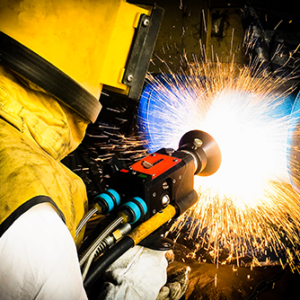8 Essential Tips for Grinding HVOF with Diamond Wheels
High-velocity oxygen-fuel or HVOF coatings represent a significant advancement in surface technology, especially in high-wear and corrosive environments. Predominantly used in the aerospace and automotive industries, these coatings are known for their exceptional hardness and wear resistance. However, the very properties that make HVOF spray coatings desirable also make them challenging to machine. This is where diamond grinding wheels come into play, offering precision and durability unmatched by other grinding methods. This comprehensive guide provides eight essential tips for effectively grinding HVOF coatings with diamond wheels.

Overview of HVOF Coatings in Industry
HVOF coatings are a type of thermal spray coating used to enhance the surface properties of a substrate, typically metals like steel or aluminum alloys. The process involves spraying a mixture of fuel and oxygen, combined with a powdered coating material – often tungsten carbide or chromium carbide – onto the substrate at high velocities. The spray process results in a dense, hard coating with excellent bond strength and wear resistance, making it ideal for components exposed to extreme wear, corrosion, or high temperatures.
The Advantages of Diamond Grinding Wheels for HVOF
Diamond grinding wheels are preferred for HVOF grinding due to their unparalleled hardness and ability to maintain a sharp cutting edge. They are particularly effective in grinding the hard, dense coatings produced by the tungsten carbide coating process, offering precise control over material removal and surface finish. Diamond's high thermal conductivity also plays a crucial role in dissipating the heat generated during grinding, thus preventing damage to both the wheel and the workpiece.
Tip 1: Opt for Resin Bond Diamond Wheels
Resin bond diamond wheels are particularly well-suited for grinding HVOF coatings. Their bond matrix allows for a smoother grinding action, which is crucial for achieving a high-quality surface finish on hard coatings like those produced by HVOF. Additionally, resin bonds can be engineered to specific formulations, catering to the unique grinding requirements of different HVOF compositions.
Tip 2: Coarse Grit for Efficient Stock Removal
When grinding HVOF coatings, starting with a coarse-grit diamond wheel can significantly improve the stock removal rate. This approach is especially effective during the initial grinding phase, allowing for rapid material removal before transitioning to finer grits for finishing operations. Coarse grits also help in reducing grinding forces, thereby minimizing the risk of substrate deformation or coating delamination.
Tip 3: Choosing Diamond Over CBN
While both diamond and CBN (Cubic Boron Nitride) wheels are superabrasives, diamond wheels are generally more effective for grinding HVOF coatings. Diamond's superior hardness makes it better suited for dealing with the high hardness of most HVOF coatings, particularly those containing tungsten carbide. CBN, though highly effective for ferrous materials, may not offer the same level of performance as the typical compositions found in HVOF coatings.
Tip 4: Regular Maintenance of Diamond Wheels
Regular dressing and truing of diamond grinding wheels are vital for maintaining their effectiveness. Dressing helps expose fresh abrasive grains, ensuring consistent grinding performance, while truing keeps the wheel in the correct geometrical shape. This maintenance is crucial for precision grinding, where the wheel's profile directly impacts the final surface quality of the HVOF coating.
Tip 5: Approach Hard HVOF Coatings Cautiously
HVOF coatings are known for their extreme hardness, often surpassing that of the substrate. When grinding these coatings, a cautious approach is advisable. Starting with lower feed rates and grinding pressures allows for an assessment of how the coating responds to the grinding process. This slow start can prevent cracking or chipping of the coating, ensuring a smooth grinding operation.
Tip 6: Utilize Coolant for Enhanced Grinding
The use of coolant in grinding HVOF coatings can significantly improve the process. Coolants help in reducing the heat generated during grinding, which is particularly important given the high hardness of HVOF coatings. Proper coolant application can extend the life of the diamond wheel, improve the surface finish, and prevent thermal damage to the substrate.
Tip 7: Consider HVOF Composition in Wheel Selection
The specific composition of the HVOF coating should be a key factor in selecting the appropriate diamond wheel. Different coating materials, such as tungsten carbide or chromium carbide, may respond differently to various diamond grit sizes and bond types. Understanding the coating's makeup can guide the selection of a wheel that offers the best balance between material removal rates and surface finish quality.
Tip 8: Optimal Wheel Speed for Extended Wheel Life
Maintaining the correct wheel speed (RPMs or SFPM) is critical for efficient grinding and extending the life of the diamond wheel. Optimal speed settings help in achieving the desired material removal rates while minimizing undue stress on the wheel. It's important to follow the manufacturer's recommendations and adjust the wheel speed according to the specific grinding task.
The Future of Grinding HVOF Coatings
As HVOF coatings continue to evolve, with new compositions and applications emerging, the role of diamond grinding wheels in their machining becomes ever more critical. Advancements in diamond wheel technology, including developments in grit sizes, bond materials, and wheel designs, are expected to further enhance the efficiency and effectiveness of the grinding process.
![]()
Grinding HVOF coatings requires a combination of the right tools, techniques, and expertise, with diamond grinding wheels playing a central role. By following these eight tips, machinists and engineers can optimize their grinding processes, achieving high-quality finishes and precise material removal. The choice of diamond wheels, along with careful consideration of the HVOF coating's properties and the grinding machine's capabilities, can lead to superior outcomes in both performance and efficiency.
Recent Posts
Subscribe to email updates
Subscribe to our blog to get the latest updates from the experts on Grinding Wheels! You can easily unsubscribe at any time




